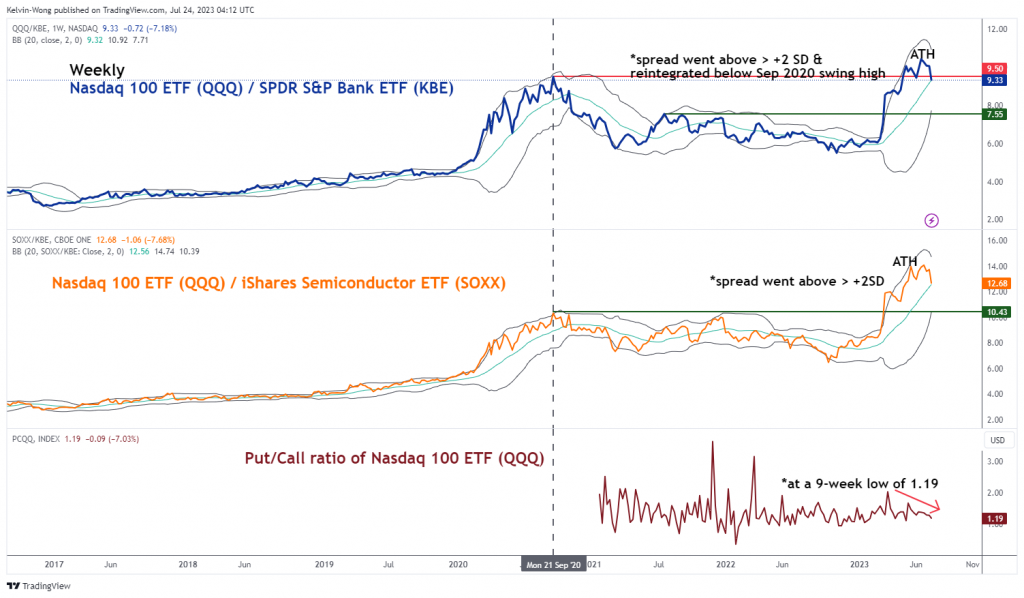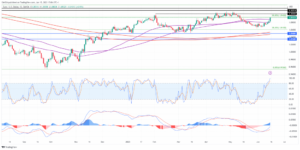- Prior underperforming US banks rallied last week where the SPDR Banks ETF rose by 6.76%, its best weekly gain seen in 14 months.
- The high growth technology concentrated Nasdaq 100, the top year-to-date performer, underperformed last week, dragged down by Tesla and Netflix ex-post earnings releases.
- Extreme positioning, and complacency bias in Nasdaq 100 increase the risk of a medium-term bearish reversal in technology stocks.
In the past two weeks, we have seen the latest Q2 earnings releases of the major US banks; JP Morgan, Bank of America, Wells Fargo, Citigroup, Goldman Sachs, Morgan Stanley, and one of the high-flying technology-related “Magnificent Seven”, Tesla as well as a Netflix. All the major banks beat earnings expectations except Goldman Sachs, but its disappointing earnings had been well-telegraphed by senior management in public speeches ahead of its result release.
Both Tesla and Netflix have managed to beat their bottom lines too. Interestingly, their respective share price performances ex-post earnings releases move in opposite directions as compared with the US banks. Based on last week’s performance for the week ended 21 July, all the major US banks recorded positive returns; JP Morgan (+3.46%), Bank of America (+9.86%), Wells Fargo (+5.51%), Citigroup (+2.84%), Goldman Sachs (+7.90%), Morgan Stanley (+9.59%) which in turn managed to have a positive spill-over effect to the broader US banking sector where the SPDR S&P Bank exchange-traded fund (ETF) recorded a weekly gain of +6.76% over the same period, its best return since the week of 23 May 2022.
In contrast, Tesla, and Netflix posted dismal weekly returns of -7.59% and -3.26% respectively as of the end of last Friday, 21 July which in turn triggered a negative feedback loop into the high growth, and technology-related broader stock indices; Nasdaq 100 (-0.90%) and iShares Semiconductor ETF (-1.44%).
Sentiment & positioning were significant contributors to Nasdaq 100 & US technology stocks’ underperformance
The main catalysts that contributed to the last week’s negative returns and underperformance of Nasdaq 100 and iShares Semiconductor ETF have been FOMO (“fear of missing out”), complacency, and extreme positioning based on a relative basis.
The Nasdaq 100 is the top-performing major stock index so far globally with a year-to-date gain of +41% as of 21 July versus a loss of -10.8% seen in the SPDR Banking ETF over the same period. Thus, technology-related equities and the Nasdaq 100 have attracted momentum chasers, especially for fund managers or market participants who missed the earlier run-up since March 2023 and the need to beat benchmark stock indices.
In addition, technology equities recorded an eight-week cumulative inflow of around US$15 billion that surpassed their cumulative peaks inflows of 2022 according to a recent BofA Global Investment Strategy research report.
Also, based on recency bias behavioral traits that extrapolate current year-to-date outperformance of Nasdaq 100 into the future, for the months ahead and even next year may have led to a higher level of complacency and extreme level of relative positioning.
US Technology stocks are at risk of further medium-term downside pressure & underperformance
Fig 1: Relative performance of Nasdaq 100 & iShares Semiconductors over SPDR Banking, put/call ratio of Nasdaq 100 as of 21 Jul 2023 (Source: TradingView, click to enlarge chart)
The chart above plots the relative performance (ratio) of Nasdaq 100 ETF (QQQ) over SPDR Banking ETF (KBE), and iShares Semiconductor ETF (SOXX) over SPDR Banking ETF (KBE). Both the ratios QQQ over KBE and SOXX over KBE have reached fresh all-time levels in June 2023 and May 2023 respectively. In addition, these two ratios have hit more than two standard deviations above their respective 20-week moving averages which suggest relatively overstretched bullish positioning in the Nasdaq 100 and semiconductor stocks.
The current reading seen in the options market indicates the bullish momentum of Nasdaq 100 is likely to persist as indicated by the put-call ratio of Nasdaq 100 ETF (QQQ) which measures the number of traded put options divided by call options on the long side. A falling ratio indicates more calls are being bought versus puts which suggests market participants are not afraid of a falling market and have a bullish bias that prices may continue to rise, and if a negative event arises, it can easily reverse prices to the downside due to complacency of market participants. Vice versa for a rising put-call ratio.
Since 15 May 2023, the put-call ratio of Nasdaq 100 ETF (QQQ) has continued to decline and as of 17 July, it stood at 1.19 which is a nine-week low. Therefore, it will be a pivotal week ahead for Nasdaq 100 and the “Magnificent Seven” as market participants await the earnings results and guidance of Microsoft, Alphabet, Texas Instruments (out on Tuesday, 25 July), and Meta Platforms (out on Wednesday, 26 July).
Content is for general information purposes only. It is not investment advice or a solution to buy or sell securities. Opinions are the authors; not necessarily that of OANDA Business Information & Services, Inc. or any of its affiliates, subsidiaries, officers or directors. If you would like to reproduce or redistribute any of the content found on MarketPulse, an award winning forex, commodities and global indices analysis and news site service produced by OANDA Business Information & Services, Inc., please access the RSS feed or contact us at info@marketpulse.com. Visit https://www.marketpulse.com/ to find out more about the beat of the global markets. © 2023 OANDA Business Information & Services Inc.
- SEO Powered Content & PR Distribution. Get Amplified Today.
- PlatoData.Network Vertical Generative Ai. Empower Yourself. Access Here.
- PlatoAiStream. Web3 Intelligence. Knowledge Amplified. Access Here.
- PlatoESG. Automotive / EVs, Carbon, CleanTech, Energy, Environment, Solar, Waste Management. Access Here.
- BlockOffsets. Modernizing Environmental Offset Ownership. Access Here.
- Source: https://www.marketpulse.com/indices/a-reversal-of-fortunes-for-us-banks-and-technology-stocks/kwong
- :has
- :is
- :not
- :where
- ][p
- 1
- 100
- 14
- 15 years
- 15%
- 17
- 19
- 2022
- 2023
- 23
- 25
- 26%
- 7
- 700
- a
- About
- above
- access
- According
- addition
- advice
- affiliates
- afraid
- ahead
- All
- Alphabet
- america
- an
- Analyses
- analysis
- and
- any
- ARE
- around
- AS
- At
- attracted
- author
- authors
- avatar
- await
- award
- Bank
- Bank of America
- Banking
- banking sector
- Banks
- based
- basis
- BE
- bearish
- been
- being
- below
- Benchmark
- BEST
- bias
- Billion
- Bofa
- both
- Bottom
- bought
- Box
- broader
- Bullish
- business
- but
- buy
- by
- call
- Calls
- CAN
- catalysts
- Chart
- Citigroup
- click
- COM
- combination
- Commodities
- compared
- Concentrated
- conducted
- Connecting
- contact
- content
- continue
- continued
- contrast
- contributed
- contributors
- courses
- Current
- Decline
- Directors
- disappointing
- dismal
- divided
- down
- downside
- due
- Earlier
- Earnings
- easily
- effect
- Elliott
- end
- enlarge
- Equities
- especially
- ETF
- Even
- Event
- Except
- exchange
- exchange-traded
- exchange-traded fund (ETF)
- expectations
- experience
- expert
- extreme
- Falling
- far
- feedback
- financial
- Find
- flow
- FOMO
- For
- foreign
- foreign exchange
- forex
- fortunes
- found
- fresh
- Friday
- fund
- fund managers
- fundamental
- further
- future
- Gain
- General
- Global
- global investment
- global markets
- Globally
- goldman
- Goldman Sachs
- Growth
- guidance
- had
- Have
- High
- higher
- Hit
- HTTPS
- if
- in
- Inc.
- Increase
- index
- indicated
- indicates
- Indices
- inflows
- information
- instruments
- into
- investment
- Investment strategy
- iShares
- IT
- ITS
- jp
- jp morgan
- July
- june
- Kelvin
- Key
- Last
- latest
- Led
- Level
- levels
- like
- likely
- lines
- Long
- loss
- Low
- Macro
- Main
- major
- managed
- management
- Managers
- March
- Market
- market outlook
- market research
- MarketPulse
- Markets
- max-width
- May..
- measures
- Meta
- META PLATFORMS
- Microsoft
- missed
- missing
- Momentum
- months
- more
- Morgan
- morgan stanley
- move
- moving
- moving averages
- Nasdaq
- Nasdaq 100
- necessarily
- Need
- negative
- Netflix
- news
- next
- number
- numerous
- of
- officers
- on
- ONE
- only
- Opinions
- opposite
- Options
- or
- out
- Outlook
- over
- participants
- passionate
- past
- performance
- performances
- performer
- period
- perspectives
- photo
- pivotal
- Platforms
- plato
- Plato Data Intelligence
- PlatoData
- please
- positioning
- positive
- posted
- Posts
- pressure
- price
- Prices
- Produced
- providing
- public
- purposes
- put
- Puts
- Q2
- ratio
- reached
- Reading
- recent
- recorded
- relative
- relatively
- release
- Releases
- report
- research
- respective
- respectively
- result
- Results
- retail
- return
- returns
- Reversal
- reverse
- Rise
- rising
- Risk
- ROSE
- rss
- S&P
- Sachs
- same
- sector
- Securities
- seen
- sell
- semiconductor
- Semiconductors
- senior
- service
- Services
- Share
- sharing
- side
- significant
- since
- Singapore
- site
- So
- so Far
- solution
- Source
- specializing
- speeches
- standard
- stanley
- stock
- Stock markets
- Stocks
- Strategist
- Strategy
- suggest
- Suggests
- surpassed
- Technical
- Technical Analysis
- Technology
- ten
- Tesla
- texas
- than
- that
- The
- The Future
- their
- therefore
- These
- thousands
- Thus
- to
- too
- top
- traded
- Traders
- Trading
- TradingView
- Training
- triggered
- Tuesday
- TURN
- two
- unique
- us
- using
- v1
- Versus
- vice
- Visit
- Wave
- we
- Wednesday
- week
- Week ahead
- weekly
- Weeks
- WELL
- Wells
- Wells Fargo
- were
- which
- WHO
- will
- winning
- with
- wong
- would
- year
- years
- You
- zephyrnet












